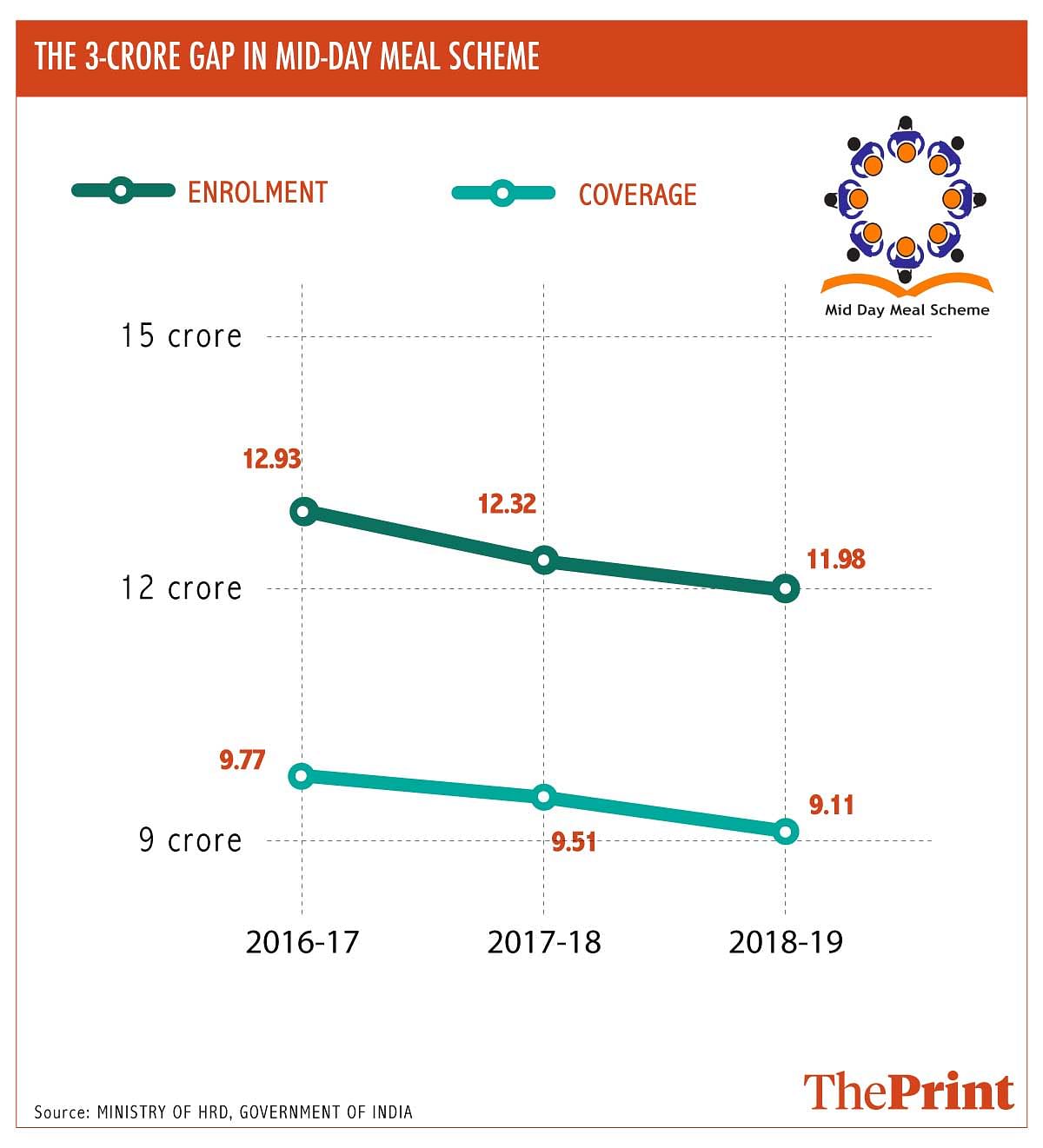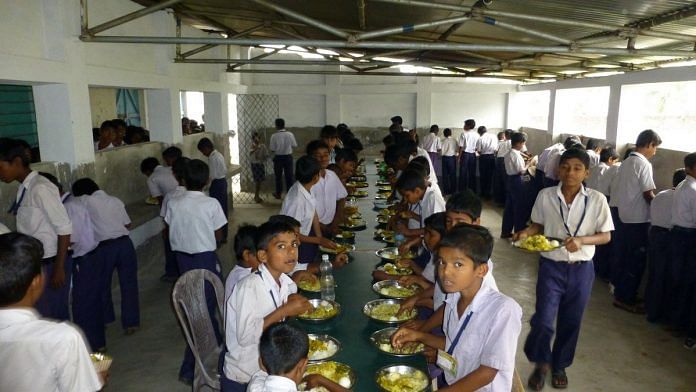New Delhi: The mid-day meal scheme in government schools across India has seen a 25 per cent gap between the number of students enrolled and those who benefited in the last three years, according to latest figures.
An analysis of the data provided by the Ministry of Human Resource Development shows there is a nearly 3-crore gap between the number of students who had enrolled in government schools during 2016-17, 2017-18 and 2018-19 and those who were covered under the mid-day meal scheme.
According to the figures, approximately 13 crore students got enrolled in schools across India in 2016-17, while 9.8 crore of them benefitted from the mid-day meal scheme. In 2017-18, the scheme covered nearly 9.52 crore students while the enrolment figure was around 12.33 crore. The year 2018 saw nearly 12 crore students getting enrolled but only around 9.12 crore covered.

While the dip in numbers raises many questions on the implementation of the flagship welfare scheme, the HRD ministry attributes the deficit to students shifting from government schools to private English medium schools after Class 3-4.
“This big gap between enrollment of kids and their coverage under mid-day meal scheme is because after class 3 and 4 a large number of them are transferred to English medium schools by their families,” said a senior education department official, who did not wish to be named.
The schools agree.
Seema Pandey, head of Bikamau Khurd Primary School in Uttar Pradesh, said while villages don’t see this migration much, it’s happening in urban areas. “My school is in a village so there isn’t much migration. But yes, in the urban areas there are parents who shift their kids to English medium schools after the primary level.”
Also read: Students’ performance in govt schools suffer if they are hungry: Study
Lure of private, English medium schools
The explanation finds resonance in the education department’s 2018 submission before a parliamentary committee.
The department had explained why the number of children enrolled in government schools between 2010-11 and 2014-15 witnessed a 15 per cent decline, even though the enrolments at private schools went up by about 33 per cent during the same period.
Subsequently, in a report on the central government’s Sarv Shiksha Abhiyan and the mid-day meal scheme, the parliamentary committee had said, “For this panel, the reduction in number of students enrolled at schools covered under mid-day meal scheme is a subject of deep concern. This trend is directly opposite to enrolments in private schools.”
The panel had asked for an inquiry to establish the reasons for this drop in the numbers and find a resolution at the earliest.
In its response, the education department had said in its reply on 5 January 2018, “This is due to rapidly growing private educational institutions. To counter this trend, some states are considering a plan to start some English medium government schools.”
The education department had expressed hope that the move would arrest the decline in enrollments in government schools.
In Uttar Pradesh, a pilot project was launched in 2018, and 5,000 English-medium schools have been since started. In these schools, the medium of instruction from class 1 to 3 is English, and it will be a combination of Hindi and English in Class 4 and 5.
Sarvendra Kumar, Director, Basic Education, who is leading this programme in UP, said, “Children are getting attracted to these schools. When it was launched as a pilot project in 2018, the plan was to launch 1,000 such schools. But now the number has gone up to 5,000.”
The move seems to have succeeded in achieving its objective to some extent. According to available data, the number of students who got enrolled in UP’s government schools during 2018-19 is nearly 1.8 crore — more than the 2016-17 figure of around 1.79 crore.
Anjali Rathore of Lucknow teaches in one such school.
“The response of parents has been really encouraging. Our students submitted a report on bio-diversity at the Wipro Earthian Awards 2018 through the Centre of Environment Education, and we won an award. The parents are really happy that their children are doing well,” said the teacher of BKT Rajapur Primary English Medium School.
Neeraj Yadav, a lab technician in a private hospital, has put his two children in the same school. “My son is in Class 1 and daughter is in Class 3. Earlier, they were going to a private English school where the fee was high and we had to bear other expenses too.”
He said many families like his are now sending their wards to government-run English medium schools.
The mid-day meal coverage, however, still saw a drop in 2018-19.
A teacher at the School of Liberal Studies at Ambedkar University, who has been actively writing on mid-day meal scheme, questioned the government claim on the gap between enrolment and coverage numbers.
“The explanation of the gap doesn’t make sense. In many cases, though, these numbers might get inflated due to many reasons like the kind of funds the schools can get with big numbers,” said the teacher, who did not wish to be named.
Right to Food convener Ayesha, however, said, “There are many reasons behind this gap. Many children do odd jobs with their parents and skip school despite enrolling. Some get enrolled for the benefits given by the government school but study in private schools.”
She also said many schools don’t provide food in accordance with the menu, which keeps the children away.
Also read: Modi govt likely to slash school education budget by Rs 3,000 crore citing funds crunch
Mid-day meal scheme in news for wrong reasons
Of late, several reports associated with the quality of the food served under the scheme have hit the headlines in UP alone.
In Mirzapur, some students were served roti and salt in a school in September this year. At a school in Sonbhadra, it was reported last month, 1 litre of milk was diluted with water and served to 81 children.
On 3 December in Muzaffarnagar, nine school children fell ill after consuming a meal contaminated by a dead rat.
The mid-day meal scheme was launched by then PM Narshimha Rao on 15 August 1995. Its main objective was to retain children in schools after enrollment, besides improving their attendance and nutrition levels.
According to the latest data shared by the school education department, nearly 11.98 crore students enrolled in Class 1 to 8 in the 11.34 lakh government-owned schools, schools receiving aid from the government, madarsas and maqtabs across India are getting benefits of the mid-day meal scheme.
Also read: After Kerala, Karnataka & Telangana schools start ringing bell to push kids to drink water



